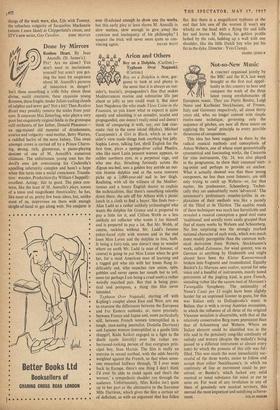Boy on a Dolphin. (Canton.)— Typhoon Over Nagasaki. (Curzon.) Boy
on a Dolphin is slow, gor- geous to look at and phony in the sense that it is always an out- sider's, tourist's, propagandist's film that makes Mediterranean marine and submarine life just about as jolly as you could want it. But since Jean Negulesco (he who made Three Coins in the Fountain, so you know what to expect) is quite openly and admitting it an outsider, tourist and propagandist, one doesn't really mind and doesn't think of comparing it with, say, our last cine- matic visit to the same island (Hydra), Michael Cacoyannis's A Girl in Black, which as an in- sider's view made things look anything but jolly. Sophia Loren, talking fast, shrill English for the first time, plays a sponge-diver called Phxdra, who like most Latin peasant women appears, to milder northern eyes, in a perpetual rage, and who one day, thrashing furiously across the iEgean sea-bed, sees a golden boy astride an out- size bronze dolphin and at the same moment picks up a 2,000-year-old nail in her thigh. Realising, with all the wiliness of the Mediter- ranean and a boozy English doctor to explain the technicalities, that there's something saleable down there, she sets off for Athens with a picnic lunch in a cloth to find a buyer. She finds two— Alan Ladd as a rather unlikely archwologisf who wants the dolphin for Greece and is prepared to pay a little for it, and Clifton Webb as a less unlikely art collector who wants it for himself and is prepared to pay a lot. But Mr. Webb, of course, reckons without Mr. Ladd's famous poker-faced style with women and in the end loses Miss Loren and the dolphin to him, both. It being a fairy-tale, one doesn't stop to wonder where on earth Mr. Ladd (a man of honour, of course) is going to put Miss Loren when he gets her, for a staid American man of learning and a ragged girl who sits with her knees flung in- delicately out, who munches raw onion, spits, gobbles and never opens her mouth but to yell, seem (or perhaps I am being a cruel snob) a rather weirdly matched pair. But that is being prac- tical and pompous, a thing this film never intended.
Typhoon Over Nagasaki, starting off with Kipling's couplet about East and West, sets out to examine the differences between the European and Far Eastern outlooks, or, more precisely, between France and Japan and, more particularly still, between French women (exemplified in a tough, man-eating journalist, Danielle Darrieux) and Japanes women (exemplified in a gentle little shopgirl, Kishi Keiko) engaged in a fight to the death (quite literally) over the rather em- barrassed-looking person of that evergreen prin- cipal boy, Jean Marais. The film is really an exercise in sexual method, with the odds heavily weighted against the French, so that when some- one remarked halfway through, `If I ever went back to Europe, there's one thing I don't think I'd ever be able to stand again and that's the women,' a sympathetic shudder ran through the audience. Unfortunately, Miss Keiko isn't quite up to her part as the alternative to the fearsome Mlle Darrieux, which gives the film a certain air of deflation, as with an argument that has fallen
flat. But there is a magnificent typhoon at the end that hits one of the women (I won't say which) on the head with a flying tile and kills her and leaves M. Marais, his golden profile lashed by the rain, holding up a wall with one shoulder, like the little Dutch try who put his fist in the dyke. Director : Yves Ciampi.
ISABEL QUIOLY


































 Previous page
Previous page